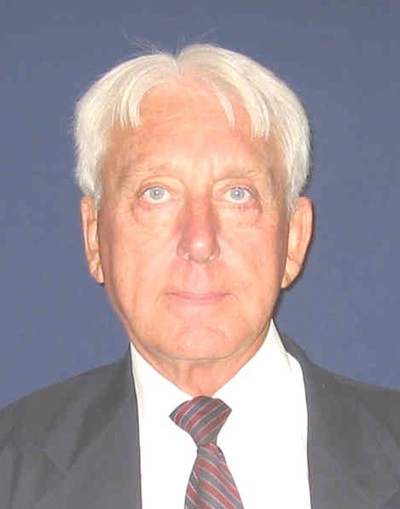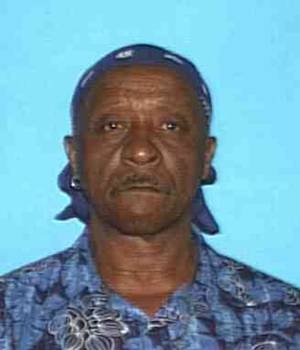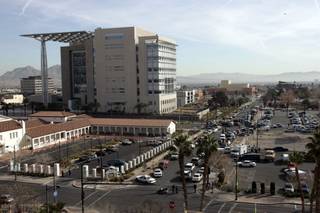
A shooting at the George Federal Building left a court security officer and the suspect dead, and a deputy U.S. marshal wounded.
Tuesday, Jan. 5, 2010 | 2 a.m.
Related Document
Federal Courthouse Shooting
A lone gunman walked into the Lloyd D. George Federal Courthouse in downtown Las Vegas and opened fire, killing a security officer.
Raw YouTube video of shooting
News conference on shooting
Federal building shooting
Monday morning’s courthouse shooting served as a reminder of just how elusive a goal it can be to design a perfectly secure building.
The George Federal Building in downtown Las Vegas was the first such facility in the nation to be designed to standards to withstand the kind of lethal blast that buckled the Alfred P. Murrah Federal Building in Oklahoma City in 1995.
But little can be done, it seems, to stop a lone gunman from entering a lobby and, before reaching the security measures, opening fire. That’s what happened Monday when a gunman, apparently angry over Social Security benefits, fired his gun just inside the courthouse lobby, killing a security officer and wounding a marshal before fleeing and being shot dead across the street.
FBI spokesman and Special Agent Joseph Dickey said the building’s security worked as well as could be expected because the gunman never got beyond the front entrance.
“The security worked exactly as designed,” Dickey said. “They kept him out of the building. He did not get inside because of the heroic acts of the officers involved.”
Opened in July 2000 at a cost of nearly $97 million, the George Federal Building was designed with a large, expansive lobby decorated in white marble with a glass ceiling.
Chief architect Les Shepherd of the General Services Administration, the federal agency that manages the building, said it was the first structure in the nation to be designed with security measures prompted by the Oklahoma City bombing. As the initial project manager for the courthouse, Shepherd said one of those measures had to do with separating X-ray screening stations at the entrance from the rest of the courthouse. “If you have any security breach, it can be kept away from the rest of the building,” Shepherd said.
It was at that entrance of the courthouse at 333 Las Vegas Blvd. South where officers initially traded fire with the lone gunman, before he was shot and killed.
Authorities said the gunman was wearing black pants, a black shirt and a black jacket with a shotgun concealed in his jacket. As he walked into the courthouse, he opened fire. The Associated Press, quoting anonymous sources, identified the gunman as Johnny Lee Wicks, 66. Wicks had sued the Social Security Administration in 2008, alleging racial discrimination because his benefits were reduced when he moved from California to Nevada. His case was dismissed.
The exterior of the courthouse, with its concrete walls and elevated plaza, was designed in part to prevent individuals from driving a bomb-carrying vehicle into the building, as was the case with the Murrah Building. The George Building, in fact, easily passed an explosives test a year before it opened.
The construction is designed to keep the building intact in the event of an explosion while also protecting anyone nearby from flying glass fragments.
Human security inside is provided by the U.S. Marshals Service through a combination of career deputy marshals and contracted security officers. One of those officers, Stanley W. Cooper, 65, was killed in the gun battle. He was a retired Metro Police officer who had been a contracted courthouse security officer since 1994 and was employed by Akal Security, the nation’s leading provider of security officers to the Marshals Service.
Based in Espanola, N.M., Akal provides security officers to 300 federal courthouses in 40 states, drawing from retired law enforcement or military personnel.
U.S. Marshals Service spokesman Jeff Carter in Washington said Cooper was armed, but Carter said he did not know whether the officer had been wearing a bulletproof vest, a question that is now part of the investigation. Dave Oney, another spokesman with the Marshals Service, said: “While we never provide specifics on our security measures, we assure you that the Marshals continue to make great strides in our judicial security mission.”
Courthouse security is very much in the minds of planners and designers who not only focus on the integrity of a building to withstand attacks, but also on the best ways to protect the public and courthouse employees, as well as the most effective ways to transport jailed suspects and convicts.
Timothy Fautsko, a courthouse security coordinator for the National Center for State Courts in Williamsburg, Va., said it is preferable to have at least three security guards at each metal detector scanning station inside a courthouse. It was not immediately known whether that was the case at the federal courthouse.
It would also be preferable to have security patrols outside the courthouse, but he said that can run into a considerable expense.
“That’s difficult to do in this era of cutback management,” Fautsko said. “There are no easy answers when it comes to external security.”
Retired Drug Enforcement Administration Agent Rande Matteson, chairman of the Criminal Justice Department at Saint Leo University in Florida, also said there is a fine line between beefing up courthouse security and allowing the public to go about their business. He said people could claim infringement of their rights should courthouse guards require them to be patted down before they enter the building.
“The security at these buildings is pretty darn good,” he said. “But I’m not sure that we can secure ourselves to the point where we are completely safe. It’s difficult to throw a net over the entire community to keep everyone safe.”




Join the Discussion:
Check this out for a full explanation of our conversion to the LiveFyre commenting system and instructions on how to sign up for an account.
Full comments policy